Linh Tran
PBM-VFL: Vertical Federated Learning with Feature and Sample Privacy
Jan 27, 2025Abstract:We present Poisson Binomial Mechanism Vertical Federated Learning (PBM-VFL), a communication-efficient Vertical Federated Learning algorithm with Differential Privacy guarantees. PBM-VFL combines Secure Multi-Party Computation with the recently introduced Poisson Binomial Mechanism to protect parties' private datasets during model training. We define the novel concept of feature privacy and analyze end-to-end feature and sample privacy of our algorithm. We compare sample privacy loss in VFL with privacy loss in HFL. We also provide the first theoretical characterization of the relationship between privacy budget, convergence error, and communication cost in differentially-private VFL. Finally, we empirically show that our model performs well with high levels of privacy.
Privacy-Preserving Personalized Federated Prompt Learning for Multimodal Large Language Models
Jan 23, 2025Abstract:Multimodal Large Language Models (LLMs) are pivotal in revolutionizing customer support and operations by integrating multiple modalities such as text, images, and audio. Federated Prompt Learning (FPL) is a recently proposed approach that combines pre-trained multimodal LLMs such as vision-language models with federated learning to create personalized, privacy-preserving AI systems. However, balancing the competing goals of personalization, generalization, and privacy remains a significant challenge. Over-personalization can lead to overfitting, reducing generalizability, while stringent privacy measures, such as differential privacy, can hinder both personalization and generalization. In this paper, we propose a Differentially Private Federated Prompt Learning (DP-FPL) approach to tackle this challenge by leveraging a low-rank adaptation scheme to capture generalization while maintaining a residual term that preserves expressiveness for personalization. To ensure privacy, we introduce a novel method where we apply local differential privacy to the two low-rank components of the local prompt, and global differential privacy to the global prompt. Our approach mitigates the impact of privacy noise on the model performance while balancing the tradeoff between personalization and generalization. Extensive experiments demonstrate the effectiveness of our approach over other benchmarks.
A Differentially Private Blockchain-Based Approach for Vertical Federated Learning
Jul 09, 2024Abstract:We present the Differentially Private Blockchain-Based Vertical Federal Learning (DP-BBVFL) algorithm that provides verifiability and privacy guarantees for decentralized applications. DP-BBVFL uses a smart contract to aggregate the feature representations, i.e., the embeddings, from clients transparently. We apply local differential privacy to provide privacy for embeddings stored on a blockchain, hence protecting the original data. We provide the first prototype application of differential privacy with blockchain for vertical federated learning. Our experiments with medical data show that DP-BBVFL achieves high accuracy with a tradeoff in training time due to on-chain aggregation. This innovative fusion of differential privacy and blockchain technology in DP-BBVFL could herald a new era of collaborative and trustworthy machine learning applications across several decentralized application domains.
Representation Learning for Sequential Volumetric Design Tasks
Sep 05, 2023Abstract:Volumetric design, also called massing design, is the first and critical step in professional building design which is sequential in nature. As the volumetric design process is complex, the underlying sequential design process encodes valuable information for designers. Many efforts have been made to automatically generate reasonable volumetric designs, but the quality of the generated design solutions varies, and evaluating a design solution requires either a prohibitively comprehensive set of metrics or expensive human expertise. While previous approaches focused on learning only the final design instead of sequential design tasks, we propose to encode the design knowledge from a collection of expert or high-performing design sequences and extract useful representations using transformer-based models. Later we propose to utilize the learned representations for crucial downstream applications such as design preference evaluation and procedural design generation. We develop the preference model by estimating the density of the learned representations whereas we train an autoregressive transformer model for sequential design generation. We demonstrate our ideas by leveraging a novel dataset of thousands of sequential volumetric designs. Our preference model can compare two arbitrarily given design sequences and is almost 90% accurate in evaluation against random design sequences. Our autoregressive model is also capable of autocompleting a volumetric design sequence from a partial design sequence.
Generalizable Pose Estimation Using Implicit Scene Representations
May 26, 2023



Abstract:6-DoF pose estimation is an essential component of robotic manipulation pipelines. However, it usually suffers from a lack of generalization to new instances and object types. Most widely used methods learn to infer the object pose in a discriminative setup where the model filters useful information to infer the exact pose of the object. While such methods offer accurate poses, the model does not store enough information to generalize to new objects. In this work, we address the generalization capability of pose estimation using models that contain enough information about the object to render it in different poses. We follow the line of work that inverts neural renderers to infer the pose. We propose i-$\sigma$SRN to maximize the information flowing from the input pose to the rendered scene and invert them to infer the pose given an input image. Specifically, we extend Scene Representation Networks (SRNs) by incorporating a separate network for density estimation and introduce a new way of obtaining a weighted scene representation. We investigate several ways of initial pose estimates and losses for the neural renderer. Our final evaluation shows a significant improvement in inference performance and speed compared to existing approaches.
MaskTune: Mitigating Spurious Correlations by Forcing to Explore
Oct 08, 2022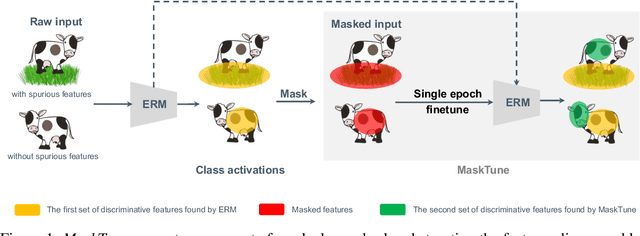
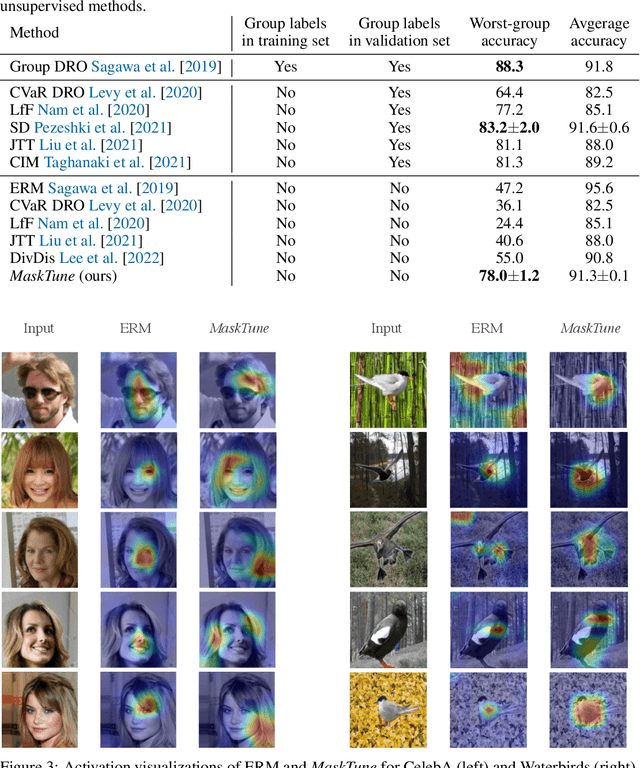
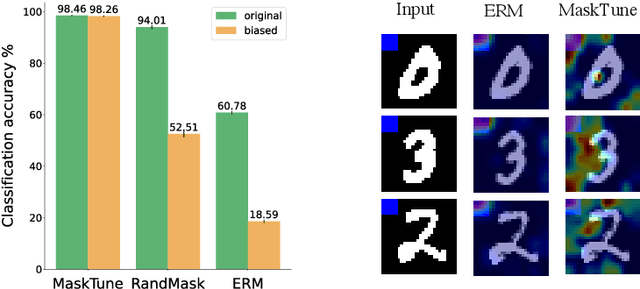

Abstract:A fundamental challenge of over-parameterized deep learning models is learning meaningful data representations that yield good performance on a downstream task without over-fitting spurious input features. This work proposes MaskTune, a masking strategy that prevents over-reliance on spurious (or a limited number of) features. MaskTune forces the trained model to explore new features during a single epoch finetuning by masking previously discovered features. MaskTune, unlike earlier approaches for mitigating shortcut learning, does not require any supervision, such as annotating spurious features or labels for subgroup samples in a dataset. Our empirical results on biased MNIST, CelebA, Waterbirds, and ImagenNet-9L datasets show that MaskTune is effective on tasks that often suffer from the existence of spurious correlations. Finally, we show that MaskTune outperforms or achieves similar performance to the competing methods when applied to the selective classification (classification with rejection option) task. Code for MaskTune is available at https://github.com/aliasgharkhani/Masktune.
SimCURL: Simple Contrastive User Representation Learning from Command Sequences
Jul 29, 2022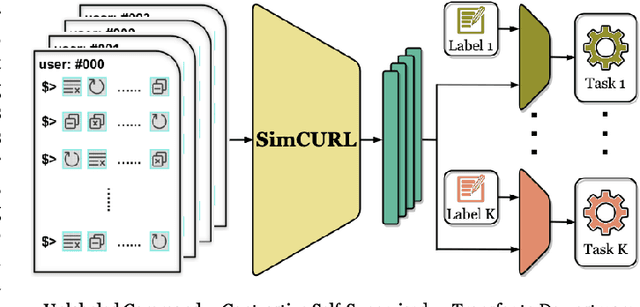

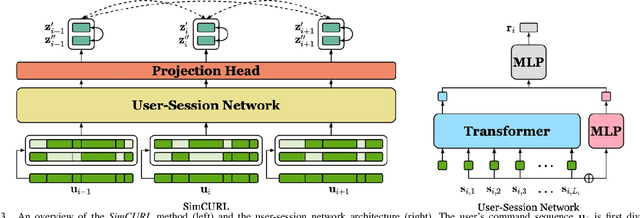

Abstract:User modeling is crucial to understanding user behavior and essential for improving user experience and personalized recommendations. When users interact with software, vast amounts of command sequences are generated through logging and analytics systems. These command sequences contain clues to the users' goals and intents. However, these data modalities are highly unstructured and unlabeled, making it difficult for standard predictive systems to learn from. We propose SimCURL, a simple yet effective contrastive self-supervised deep learning framework that learns user representation from unlabeled command sequences. Our method introduces a user-session network architecture, as well as session dropout as a novel way of data augmentation. We train and evaluate our method on a real-world command sequence dataset of more than half a billion commands. Our method shows significant improvement over existing methods when the learned representation is transferred to downstream tasks such as experience and expertise classification.
Counterbalancing Teacher: Regularizing Batch Normalized Models for Robustness
Jul 04, 2022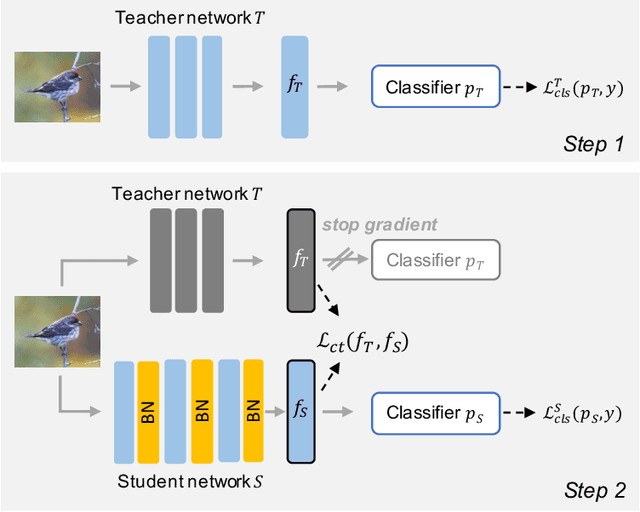


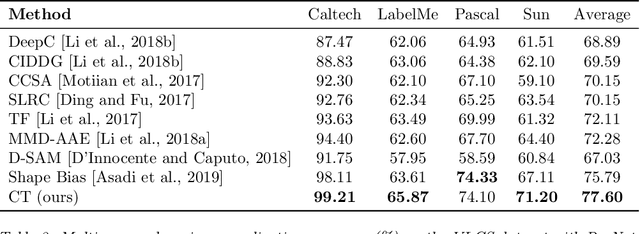
Abstract:Batch normalization (BN) is a ubiquitous technique for training deep neural networks that accelerates their convergence to reach higher accuracy. However, we demonstrate that BN comes with a fundamental drawback: it incentivizes the model to rely on low-variance features that are highly specific to the training (in-domain) data, hurting generalization performance on out-of-domain examples. In this work, we investigate this phenomenon by first showing that removing BN layers across a wide range of architectures leads to lower out-of-domain and corruption errors at the cost of higher in-domain errors. We then propose Counterbalancing Teacher (CT), a method which leverages a frozen copy of the same model without BN as a teacher to enforce the student network's learning of robust representations by substantially adapting its weights through a consistency loss function. This regularization signal helps CT perform well in unforeseen data shifts, even without information from the target domain as in prior works. We theoretically show in an overparameterized linear regression setting why normalization leads to a model's reliance on such in-domain features, and empirically demonstrate the efficacy of CT by outperforming several baselines on robustness benchmarks such as CIFAR-10-C, CIFAR-100-C, and VLCS.
COIL: Constrained Optimization in Learned Latent Space -- Learning Representations for Valid Solutions
Feb 07, 2022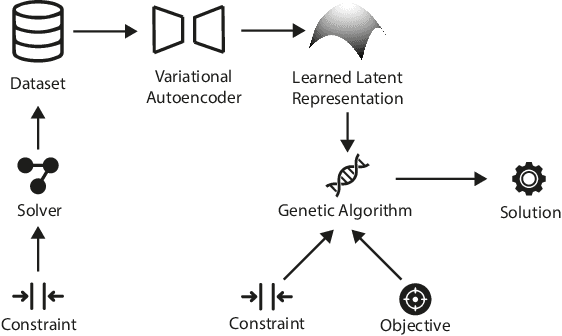
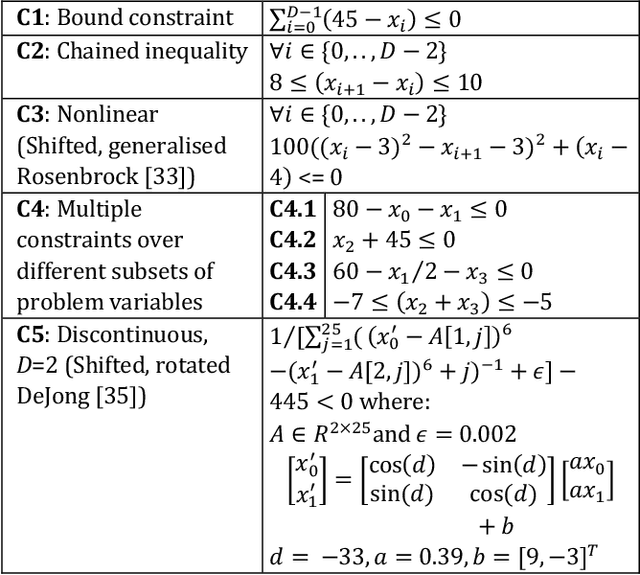

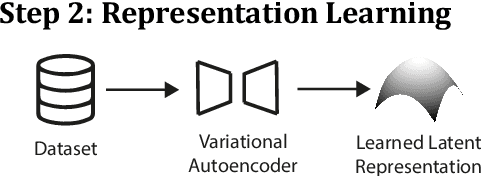
Abstract:Constrained optimization problems can be difficult because their search spaces have properties not conducive to search, e.g., multimodality, discontinuities, or deception. To address such difficulties, considerable research has been performed on creating novel evolutionary algorithms or specialized genetic operators. However, if the representation that defined the search space could be altered such that it only permitted valid solutions that satisfied the constraints, the task of finding the optimal would be made more feasible without any need for specialized optimization algorithms. We propose the use of a Variational Autoencoder to learn such representations. We present Constrained Optimization in Latent Space (COIL), which uses a VAE to generate a learned latent representation from a dataset comprising samples from the valid region of the search space according to a constraint, thus enabling the optimizer to find the objective in the new space defined by the learned representation. We investigate the value of this approach on different constraint types and for different numbers of variables. We show that, compared to an identical GA using a standard representation, COIL with its learned latent representation can satisfy constraints and find solutions with distance to objective up to two orders of magnitude closer.
JoinABLe: Learning Bottom-up Assembly of Parametric CAD Joints
Nov 24, 2021



Abstract:Physical products are often complex assemblies combining a multitude of 3D parts modeled in computer-aided design (CAD) software. CAD designers build up these assemblies by aligning individual parts to one another using constraints called joints. In this paper we introduce JoinABLe, a learning-based method that assembles parts together to form joints. JoinABLe uses the weak supervision available in standard parametric CAD files without the help of object class labels or human guidance. Our results show that by making network predictions over a graph representation of solid models we can outperform multiple baseline methods with an accuracy (79.53%) that approaches human performance (80%). Finally, to support future research we release the Fusion 360 Gallery assembly dataset, containing assemblies with rich information on joints, contact surfaces, holes, and the underlying assembly graph structure.
 Add to Chrome
Add to Chrome Add to Firefox
Add to Firefox Add to Edge
Add to Edge